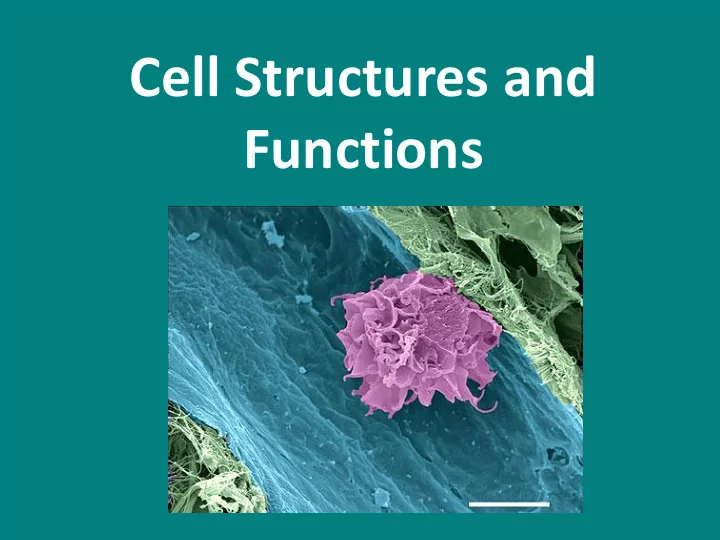

Cell Structures and Functions
What are cells? • Cells are the basic units of living organisms
Microscopes • Scientists use microscopes to view cells
Scientists Who Contributed to Early Cell Research • Robert Hooke • Anton van Leeuwenhoek • Mathias Schleiden • Theodor Schwann • Rudolf Virchow
Robert Hooke • 1665 • Observes cork under a microscope • Observes tiny chambers which he calls “cells”
Anton van Leeuwenhoek • 1683 • Observes microorganisms in pond water • Observes microscopic animal-like protozoans
Matthias Schleiden • 1838 • Botanist, proposed that all plants are composed of cells, also researched fungi
Theodor Schwann • 1839 • Zoologist, studied histology (microscopic structure of tissues) • Proposed that all animals are composed of cells
Rudolf Virchow • 1855 • Observed dividing cells under a microscope • Proposed that all cells are produced from pre- existing cells
Cell Theory • Three components to the cell theory : – All living organisms are composed of one or more cells – Cells are the basic unit of structure and function in all living organisms – Cells arise only from previously existing cells
Unicellular Organisms • Composed of only one cell • Include all bacteria, some fungi and some protists
Multicellular Organisms • Composed of more than one cell • Includes all plants and animals, some fungi and some protists
Multicellular Levels of Organization • Multicellular organisms are composed of cells which are then organized further into tissues , organs and organ systems
Cell Diversity • There are many different cell types and each cell type has a unique function in the organism • Structure of the cell type usually reflects function
Cell Diversity
Prokaryotic and Eukaryotic Cells • Prokaryotic cells are bacteria (unicellular) with no true nucleus or membrane-bound organelles • Eukaryotic cells are cells with a defined nucleus and membrane-bound organelles
Similarities Between All Cells • All cells (prokaryotic and eukaryotic) contain DNA , cytoplasm , a plasma membrane and ribosomes
Prokaryotic Cells • Prokaryotic cells are smaller, less complex in structure, evolved before eukaryotic cells, and contain a single circular chromosome • Primitive cell type (~ 3.5 billion years ago)
Eukaryotic Cells • Eukaryotic cells are larger, more complex in structure, evolved after prokaryotic cells, and contain many linear chromosomes • Recent cell type (~ 2 billion years ago)
Theory of Endosymbiosis • Proposes the origin of eukaryotic cells • The theory of endosymbiosis proposes that eukaryotic cells formed from a symbiotic relationship among several different prokaryotic cells • Symbiosis = two different species benefit from living and working together
Theory of Endosymbiosis
Internal Organization of Cells • Organelles are specialized structures within living cells • Each organelle performs essential cell function , such as protein synthesis and energy transformation
Recommend
More recommend